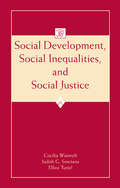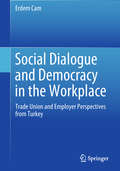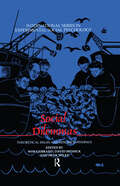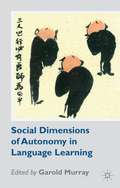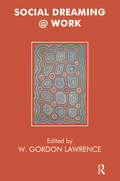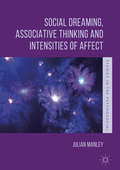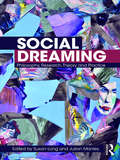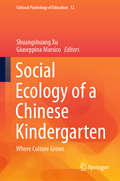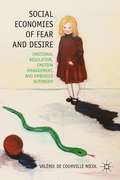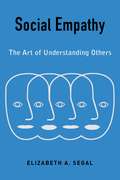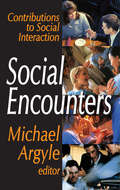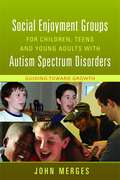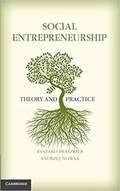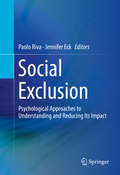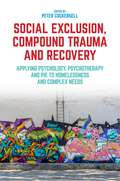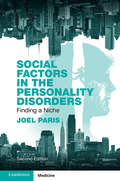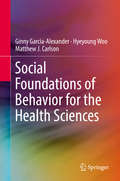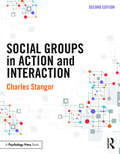- Table View
- List View
Social Development, Social Inequalities, and Social Justice (Jean Piaget Symposia Ser.)
by Cecilia Wainryb Judith G. Smetana Elliot TurielThis volume considers previously separate bodies of research on social justice, social equality, and social development. Eminent scholars from a variety of disciplines discuss the latest research to help us understand the relation between social inequalities and social development. In so doing, the book documents the powerful ways that social inequ
Social Deviance: Readings In Theory And Research
by Stephen M. Rosoff Henry N. PontellIn its first edition with McGraw-Hill, this comprehensive source of classic and contemporary readings will help students learn who becomes deviant, why people become deviant, and how individual and institutional reactions help define the social reality of deviants (the persons) and deviance (the behavior). The selected readings provide experiences for students by providing a solid foundation in the field and a means by which to examine contemporary issues.
Social Dialogue and Democracy in the Workplace: Trade Union and Employer Perspectives from Turkey
by Erdem CamThis book focuses on the experience of social dialogue in Turkey, which is a European Union candidate country. It argues that social dialogue constitutes one of the fundamental pillars of European social model and therefore should be analysed not only at the supranational level but also at the national, sectoral and workplace levels. The book critically examines social dialogue processes and mechanisms in Turkey at various levels, with focus on the workplace because it is shaped by socio-cultural elements which contain many variables. The book also identifies the shortcomings and structural impediments of social dialogue, and provides an empirically grounded theoretical explanation of social dialogue in Turkey. In the process, the book explains and clarifies key concepts to help readers grasp important points relevant to social dialogue, and contains interviews with social partners to take into consideration their views and recommendations on social dialogue. These in-depth interviews also provide a rare insight into the dynamics of social dialogue on the ground. By looking at social dialogue at various levels, the book offers a balanced view of its strengths and weaknesses in Turkey. This book is a valuable tool for students, academics and researchers interested in understanding the complex dynamics of social dialogue and workplace relations in Turkey.
Social Dilemmas: Theoretical Issues and Research Findings (International Series in Social Psychology #Vol. 25)
by David M. Messick Wim B. G. Liebrand Henk A. M. WilkeThis book describes the advances and insights made by social scientists from around the world into the understanding and resolution of social dilemmas. Each chapter discusses its own research findings against the background of a more comprehensive view of social dilemnas.
Social Dimensions of Autonomy in Language Learning
by Garold MurrayThis book examines how autonomy in language learning is fostered and constrained in social settings through interaction with others and various contextual features. With theoretical grounding, the authors discuss the implications for practice in classrooms, distance education, self-access centres, as well as virtual and social learning spaces.
Social Dominance
by Jim Sidanius Felicia PrattoThis volume focuses on two questions: why do people from one social group oppress and discriminate against people from other groups? and why is this oppression so mind numbingly difficult to eliminate? The answers to these questions are framed using the conceptual framework of social dominance theory. Social dominance theory argues that the major forms of intergroup conflict, such as racism, classism and patriarchy, are all basically derived from the basic human predisposition to form and maintain hierarchical and group-based systems of social organization. In essence, social dominance theory presumes that, beneath major and sometimes profound difference between different human societies, there is also a basic grammar of social power shared by all societies in common. We use social dominance theory in an attempt to identify the elements of this grammar and to understand how these elements interact and reinforce each other to produce and maintain group-based social hierarchy.
Social Dreaming @ Work
by David Armstrong W. Gordon Lawrence"Social Dreaming" is the name given to a method of working with dreams that are shared and associated to within a gathering of people, coming together for this purpose. Its immediate origins date back to the early 1980s. At that time, Gordon Lawrence was on the scientific staff of the Tavistock Institute of Human Relations. He was a core member of the Institute's Group Relations Programme, within which he had developed a distinctive approach centring around the concept of "relatedness" — that is, the ways in which individual experience and behaviour reflects and is structured by conscious and unconscious constructs of the group or organization in the mind...
Social Dreaming in the 21st Century: The World We Are Losing
by John Clare Ali ZarbafiWe are running out of ideas in Western society. Faced with global warming, Third World devastation, nuclear proliferation and the threat posed by religious conflict, we need new ways of thinking. After the loss and carnage of the Twentieth Century there is prevailing mood of uncertainty and paranoia, yet at the same time a denial of tragedy, a salvation fantasy, an illusion that we will be saved. The decline in social solidarity, the fragmentation of communal values and a growing sense of 'I' as opposed to 'we', are all signs of an inversion of moral certitudes, a disconnection from reality. This book asks what methods do we have at our disposal to understand and reverse this breakdown of communication within and between communities.
Social Dreaming, Associative Thinking and Intensities of Affect (Studies in the Psychosocial)
by Julian ManleyThis book describes a way of sharing dreams in a group, called ‘social dreaming’. It explores how the sharing of real, night time dreams, in a group, can offer information on and insight into ourselves and the worlds we live in and share. It investigates how we can turn dream images, and ideas and feelings that arise from these images, into conscious thought, before describing the ways in which these can be used. Using a background of the psychosocial combined with a philosophical lens influenced by the work of Gilles Deleuze, Julian Manley shows how social dreaming can be understood as a Deleuzian ‘rhizome of affects’, a web or a root design where things interconnect in a random and spontaneous fashion rather than in a sequential or linear way. He illustrates how social dreaming can link dreams together into a collage of images, and compares this to the rhizome, where clusters of emotional intensity – which emerge from the dream images – weave and interconnect with other clusters, forming a web of interlinked dream images and emotions. From the basis of this rhizome emerges an interpretation of social dreaming as a ‘body without organs’ and the social dreaming matrix as a ‘smooth space’ where meanings emerge from the way these images form connections, and come and go according to our emotions at any particular moment.
Social Dreaming: Philosophy, Research, Theory and Practice (Studies in the Psychosocial)
by Susan Long Julian ManleyThe idea of social dreaming argues that dreams are relevant to the wider social sphere and have a collective resonance that goes beyond the personal narrative. In this fascinating collection, the principles of social dreaming are explored to uncover shared anxieties and prejudices, suggest likely responses, enhance cultural surveys, inform managerial policies and embody community affiliation. Including, for the first time, a coherent epistemology to support the theoretical principles of the field, the book reflects upon and extends the theory and philosophy behind the method, as well as discussing new research in the area, and how social dreaming practice is conducted in a range of localities, situations and circumstances. The book will appeal to anyone interested in the idea that social dreaming can help us to delve deeper into the question of what it means to be human, from psychoanalysts to sociologists and beyond.
Social Ecology of a Chinese Kindergarten: Where culture grows (Cultural Psychology of Education #12)
by Giuseppina Marsico Shuangshuang XuThis book is the outcome of a joint collaboration between East China Normal University and the University of Luxembourg, initiated by the Center of Ideas for the Basic Education of the Future (IBEF), and focuses on kindergartens in China from a cultural psychology perspective. By coupling young scholars from diverse cultural backgrounds as research tandems, this book uses an innovative methodological method to reveal a deeply immersing research perspective of the often complicated issues in the Chinese social reality, where long historical tradition and strong motivation for a “modernized” future are fused together and continuously evolve itself into a vibrant and intricate landscape. Meanings and values consciously or unconsciously promoted and conducted in the kindergarten are semiotic devices and they mediate children’s and educator’s daily behaviours and activities, which are constantly navigating among different social institutions and crossing the border of kindergarten. The book discusses the process of children’s socialization in the kindergarten from different angles such as cultural objects, moral education, conflict negotiation, children's drawing analysis and the role of Lego in numeracy development. It also provides an overview of basic educational needs in Chinese kindergartens as well as three commentaries to provide background information and to add a reflective angle for the readers. By reading the book, readers will hopefully go through a constantly transforming process between familiarizing and de-familiarizing along with the research tandem and develop their own understanding of the complex landscape of the Chinese kindergarten and its children as developing subjects constantly living and transcending the context.
Social Economies of Fear and Desire: Emotional Regulation, Emotion Management, and Embodied Autonomy
by Valérie de Courville NicolAll behaviours, indeed all forms of agency, are viewed as emotionally-driven. This book provides an approach to emotional experience and agency which drastically nuances the commonly held view that fear has predominantly irrational, morally, or ideologically suspect effects which thwart the exercise of autonomy.
Social Empathy: The Art of Understanding Others
by Elizabeth SegalOur ability to understand others and help others understand us is essential to our individual and collective well-being. Yet there are many barriers that keep us from walking in the shoes of others: fear, skepticism, and power structures that separate us from those outside our narrow groups. To progress in a multicultural world and ensure our common good, we need to overcome these obstacles. Our best hope can be found in the skill of empathy.In Social Empathy, Elizabeth A. Segal explains how we can develop our ability to understand one another and have compassion toward different social groups. When we are socially empathic, we not only imagine what it is like to be another person, but we consider their social, economic, and political circumstances and what shaped them. Segal explains the evolutionary and learned components of interpersonal and social empathy, including neurobiological factors and the role of social structures. Ultimately, empathy is not only a part of interpersonal relations: it is fundamental to interactions between different social groups and can be a way to bridge diverse people and communities. A clear and useful explanation of an often misunderstood concept, Social Empathy brings together sociology, psychology, social work, and cognitive neuroscience to illustrate how to become better advocates for justice.
Social Encounters: Contributions to Social Interaction
by Michael ArgyleSocial Encounters is an approach to social psychology that is not what one might expect to find in textbooks on this subject. As a companion to Social Interaction advocated by Michael Argyle and his associates, it has been used by a rapidly growing number of researchers in social psychology, and related aspects of ethology, anthropology, and linguistics. The two key ideas are to study the detailed processes of social interaction at the level of the elements of interaction, and to relate social behavior to its biological basis and cultural setting.This work collects excellent representative studies of different aspects of social interaction; as such they are important in their own right. Within the general approach described, a range of different academic orientations are included. All selections report empirical findings, and most of them introduce conceptual notions as well. One achievement of the volume has been to establish the basic elements of which social interaction consists; current research is concerned with finding out precisely how these elements function.The contributors agree that the field consists of various signals: verbal and non-verbal, tactile, visible and audible, bodily contact, proximity, orientation, bodily posture, physical appearance, facial expression, movements of head and hands, direction of gaze, timing of speech, emotional tone of speech, speech errors, type of utterance and linguistic structure of utterance. These elements can be further analyzed and divided into categories or dimensions; each plays a distinctive role in social interaction. Social behavior is studied in natural settings or replicas of natural settings, for which there are cultural rules familiar to the subjects. This is a pioneering statement in sociobiology.
Social Enjoyment Groups for Children, Teens and Young Adults with Autism Spectrum Disorders
by John MergesYoung people with autism spectrum disorders (ASD) often feel uncomfortable and anxious in social situations, but socializing with classmates and colleagues can be made easier - and more enjoyable - with Guiding Toward Growth group sessions. John Merges' simple yet effective program for teaching social enjoyment skills is based on the concept that there are ten hurdles that make it challenging for people with ASD to enjoy social interaction. This book guides the reader through planning, running, and assessing group sessions that have been designed to help participants overcome these hurdles, interact with confidence, and ultimately enjoy more independent and fulfilling lives. As social interaction is a vital element of any work environment, this book also teaches young adults with ASD an important employment skill. This adaptable book can be used with a wide range of ages and communicative abilities, and will be an invaluable resource for all professionals working with groups of children and young people with ASD.
Social Entrepreneurship: Theory and Practice
by Ryszard Praszkier Andrzej NowakSocial Entrepreneurship: Theory and Practice is about the creative ways in which social entrepreneurs solve pressing and insurmountable social problems. Theories of social change are presented to help demystify the 'magic' of making an immense, yet durable and irreversible, social impact. Utilizing case studies drawn from various fields and all over the world, the authors document how social entrepreneurs foster bottom-up change that empowers people and societies. They also review the specific personality traits of social entrepreneurs and introduce the new kind of leadership they represent. This book will be valuable to undergraduate, graduate and postgraduate students, while remaining accessible to non-academic readers thanks to its clear language, illustrative case studies and guidelines on how to become a successful social entrepreneur.
Social Exchanges: Interpersonal Skills For College And Beyond
by Tasha F. DavisSocial Exchanges: Interpersonal Skills For College And Beyond by Tasha F. Davis
Social Exclusion
by Paolo Riva Jennifer EckFrom ostracism on the playground to romantic rejection, bullying at work, and social disregard for the aged, individuals are at constant risk of experiencing instances of social exclusion, including ostracism, rejection, dehumanization, and discrimination. These phenomena have a powerful impact as testified by their immediate influence on people's thoughts, emotions, and behaviors. Social Exclusion: Psychological Approaches to Understanding and Reducing Its Impact investigates different psychological approaches, across multiple psychological subdisciplines, to understanding the causes and consequences of social exclusion and possible ways to reduce or buffer against its negative effects. The purpose of this volume is threefold. First, it lays the groundwork for the understanding of social exclusion research; reviewing the different instances of social exclusion in everyday life and methods to experimentally investigate them. Second, this volume brings together different psychological approaches to the topic of social exclusion. Leading scholars from around the world contribute perspectives from social psychology, social neuroscience, developmental psychology, educational psychology, work and organizational psychology, clinical psychology, and social gerontology to provide a comprehensive overview of social exclusion research in different psychological subdisciplines. Taken together, these chapters are conducive to the important development of new and more integrative research models on social exclusion. Finally, this volume discusses psychological strategies such as emotion regulation, psychological resources, and brain mechanisms that can reduce or buffer against the negative consequences of social exclusion. From school shootings to domestic violence, from cognitive impairment to suicide attempts, the negative impact of social exclusion has been widely documented. Thus, from an applied perspective, knowing potential ways to mitigate the negative effects of social exclusion can have a significant positive influence on people's--and society's--well-being. Overall, this book provides the reader with the knowledge to understand the impact of social exclusion and with tools to address it across many different contexts. Importantly, Social Exclusion: Psychological Approaches to Understanding and Reducing Its Impact aims to bridge the gap between the approaches of different psychological subdisciplines to this topic, working towards a comprehensive, integrative model of social exclusion.
Social Exclusion in Later Life: Interdisciplinary and Policy Perspectives (International Perspectives on Aging #28)
by Kieran Walsh Thomas Scharf Sofie Van Regenmortel Anna WankaDrawing on interdisciplinary, cross-national perspectives, this open access book contributes to the development of a coherent scientific discourse on social exclusion of older people. The book considers five domains of exclusion (services; economic; social relations; civic and socio-cultural; and community and spatial domains), with three chapters dedicated to analysing different dimensions of each exclusion domain. The book also examines the interrelationships between different forms of exclusion, and how outcomes and processes of different kinds of exclusion can be related to one another. In doing so, major cross-cutting themes, such as rights and identity, inclusive service infrastructures, and displacement of marginalised older adult groups, are considered. Finally, in a series of chapters written by international policy stakeholders and policy researchers, the book analyses key policies relevant to social exclusion and older people, including debates linked to sustainable development, EU policy and social rights, welfare and pensions systems, and planning and development. The book’s approach helps to illuminate the comprehensive multidimensionality of social exclusion, and provides insight into the relative nature of disadvantage in later life. With 77 contributors working across 28 nations, the book presents a forward-looking research agenda for social exclusion amongst older people, and will be an important resource for students, researchers and policy stakeholders working on ageing.
Social Exclusion, Compound Trauma and Recovery: Applying Psychology, Psychotherapy And Pie To Homelessness And Complex Needs
by John Connolly Peter Cockersell Nicola Saunders Dr Emma Williamson Catriona Reid Dr Sally Read Terry HuttonResponding to the growing number of psychologically-informed services for people experiencing social exclusion and, in particular, homelessness, this book gives professionals the information and understanding they need to be fully informed in their practice with this client group. It begins with theory, looking at the psychology of social exclusion and the processes that underlie it, and considers the relationship between trauma, complex needs, homelessness and social exclusion. Presenting practical interventions and case studies, the authors then reveal what makes an effective service in practice and a client perspective on social exclusion and recovery is provided. This is essential reading for all those involved in developing services that meet the needs of socially excluded people with histories of complex trauma or presentations of complex needs, including those who are homeless, refugees and asylum seekers, Traveller and Roma communities and people involved with the criminal justice system.
Social Fabrics of the Mind (Psychology Library Editions: Social Psychology #7)
by Michael R.A. ChanceOriginally published in 1988, this book outlines a new evolutionary paradigm for understanding human society and mental structure, originating from the editor's work in primate ethology. It is supported and further elaborated by the contributors. Chance argues that two modes of social interaction, the agonic and hedonic, underlie social life and corresponding mentality. In the agonic mode we are concerned with self-security and our attention is much taken up with being accepted by a group. This mode is based on a recently discovered state of inhibited (braked) mental arousal. Social behaviour is either authoritarian or authority subservient, and has a tendency to control or be controlled. It curbs intelligence and restricts personality development. In the hedonic mode we are freer to form a network of personal relationships that are typically mutually supportive. The hedonic mode leads to the development of self-confidence and a relaxed empathic and collaborative personality with intelligence enhanced. The volume will still be of interest to all concerned with human affairs including those working in ethology, primatology, anthropology, social psychology, psychiatry and political sociology.
Social Factors in the Personality Disorders: Finding a Niche (Studies In Social And Community Psychiatry Ser.)
by Joel ParisStudies reveal that nearly 10% of the adult population meet criteria for an official diagnosis of personality disorder. Personality disorders have been shown to be strongly influenced by biological and psychological factors, however, less attention has been paid to the social context of these disorders. Synthesizing over 25 years of research since the first edition, this book explores how certain social forces can amplify heritable traits into disorders. It considers these interactions in the framework of a broad biopsychosocial model. Chapters cover clinically important categories, including borderline, narcissistic, and antisocial personality, as well as topics such as modernity, exploring how rapid social change is acting as a major risk factor for these disorders. Concise, balanced, and evidence-based throughout, this important book offers a unique perspective and shows how this can inform treatment decisions for all mental health professionals. It will also be of interest to researchers in the social sciences.
Social Foundations Of Thought And Action: A Social Cognitive Theory (Prentice-hall Series In Social Learning Theory)
by Albert BanduraPresents a comprehensive theory of human motivation and action from a social-cognitive perspective. This insightful text addresses the prominent roles played by cognitive, vicarious, self-regulatory, and self-reflective processes in psychosocial functioning; emphasizes reciprocal causation through the interplay of cognitive, behavioral, and environmental factors; and systematically applies the basic principles of this theory to personal and social change.
Social Foundations of Behavior for the Health Sciences
by Ginny Garcia-Alexander Hyeyoung Woo Matthew J. CarlsonThis textbook helps students in the health sciences prepare for the social foundations portion of the Medical College Admission Test (MCAT). It provides a solid understanding of the fundamental concepts, theories, and methodologies in sociology that the MCAT exam requires. This book offers a condensed overview of the sociological concepts covered during a 15 week semester. It helps students gain an understanding of the social foundations of behavior, and the social determinants of health within the professional context of medicine. Students are provided with the necessary basics in addition to case studies, learning and research activities, recommended external resources, and study questions. These are meant to develop pre-health students' understanding of the importance of the social factors that influence health outcomes. The featured activities contain various exercises using examples of sociology of health and medicine, including social factors shaping health, social relations between doctors and patients, and the health care system, among others. As a result, this book well informs not only those who wish to prepare for the MCAT to pursue a career in the health profession, but also anyone who is interested in social perspectives on health and medicine.
Social Groups in Action and Interaction: 2nd Edition (Psychology Ser.)
by Charles StangorSocial Groups in Action and Interaction reviews and analyzes the human group as it operates to create both social good and, potentially, social harm. It summarizes current knowledge and contemporary research, with real-world examples in succinct yet engaging chapters, to help students understand and predict group behavior. Unlike other texts, the book considers a wide range of topics--such as conformity, leadership, task performance, social identity, prejudice, and discrimination--from both an intragroup and an intergroup perspective. By looking at behavior both within and between groups, it bridges the gap between these interconnected approaches. The second edition is thoroughly updated to include new discussion of the biology and neuroscience of group formation, recent developments in social identity theory, and recent advances in the study of social networks. It also includes questions for review and discussion in the classroom. It provides the most comprehensive and essential resource for courses on group dynamics and behavior.
